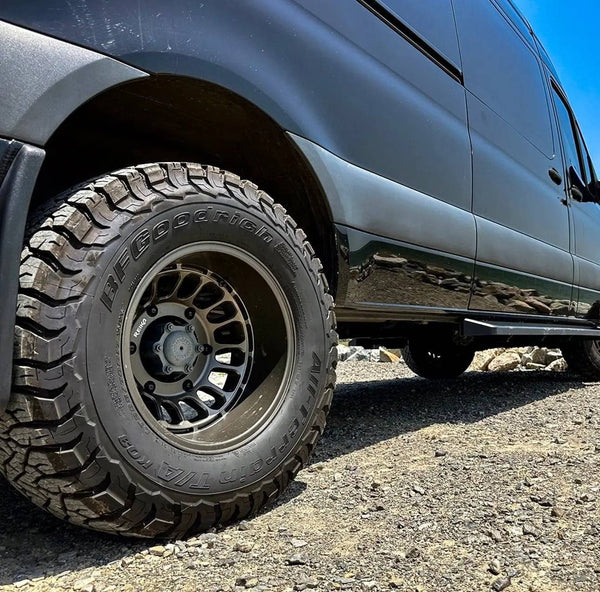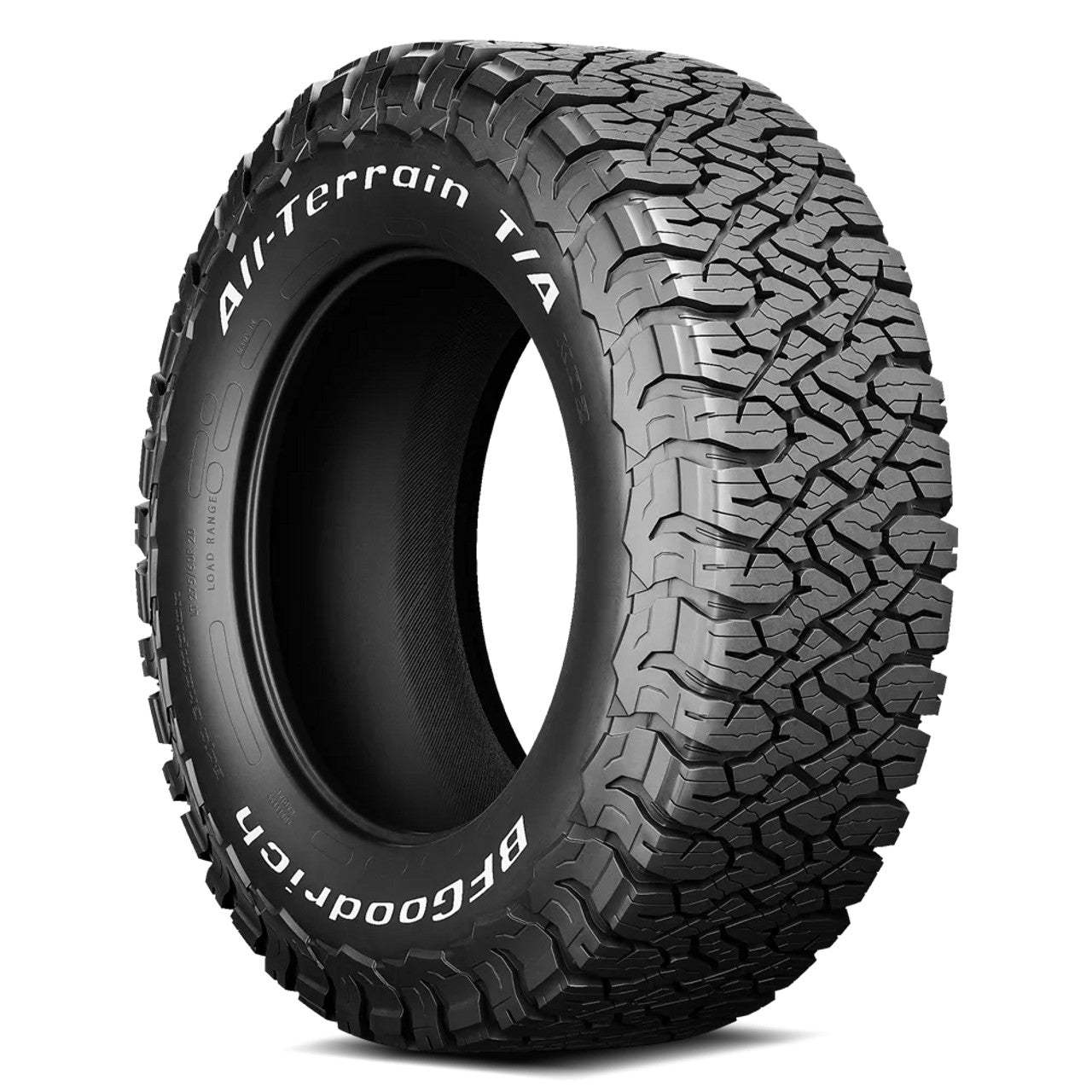The Owl Journal
What is Wheel Offset and Backspacing? Information for Sprinter Vans
Offset and backspacing are confusing terms for most people. When you hear these phrases, you might picture a low-riding streetcar with a wide stance or an off-roading Jeep with massive monster truck tires. Both of these images are great examples of offset, but did you realize that offset can also apply to your Sprinter van wheels?
Below, we’ll take a deep dive into what wheel offset and backspacing are, why they matter for tire and wheel fitment, and how vehicle performance can be altered. With this information, you’ll have a clear understanding of what you need to keep in mind for your van’s next wheel and tire upgrade.
What is Offset on Wheels?
Let’s start with a general explanation from Edmunds and break this apart further:
Offset helps determine whether the wheel will fit flush with the car's body, be recessed into the wheel well, or stick out.
To better understand what wheel offset is, first picture how a Sprinter’s wheels attach to the vehicle. There are 6 bolt holes on the wheel that slide over the bolts on the wheel hub. These are then secured with lug nuts on the outside of the wheel.
Now, picture the tire and wheel from its side (looking at the tread). Imagine you have X-ray vision of where the mounting holes are located inside:
-
If the mounting holes are directly in the center of the wheel, the wheel would sit perfectly flush with the body of the car. This is called zero offset.
-
If the mounting holes are located closer to the outside, street-side of the wheel, the wheel would sit further inside the wheel well. This is called positive offset.
-
If the mounting holes are located closer to the inside, vehicle-side of the wheel, the wheel would stick out from the wheel well more. This is called negative offset.

What is Backspacing?
Backspacing describes the same concept as offset, but with a different measurement. Instead of measuring how much the mounting surface and holes are off-center, it measures how far the mounting surface is from the vehicle’s wheel hub. It’s measured in inches.
For example, if a wheel’s mounting holes are closer to the inside of the tire (near the vehicle), it will have less backspacing. If the holes are on the outside of the tire (near street-side), it will have more backspacing.
-
More backspacing = the tire sits under the wheel well more.
-
Less backspacing = the tire sits outside the wheel well more.
How to Measure Wheel Offset
Offset is a measurement of how off-center a wheel’s mounting surface is.
When you’re shopping for new wheels for your Sprinter, you’ll see offset described as a number. For example, the Talon Super Singles offer a -123mm offset, which is the widest available. What this number means is that the mounting holes are 123mm off-center, closer to the vehicle side. Remember, a negative offset means closer mounting; a positive offset means further mounting.
You can calculate your offset using a formula:
Offset (mm) = (Backspacing - Centerline) x 25.4
1. Calculate Centerline
To calculate the centerline of your wheel in inches, measure from one outer lip of the rim to the other outer lip (with the tire removed). Divide this number by two.
2. Calculate Backspacing
Flip the wheel onto its face so that the street-facing side is on the ground. Once flipped, place a straight edge across the top of the wheel. Using a tape measure, measure the distance in inches from the inner mounting face of the wheel to the straight edge.
3. Complete the Formula
With these measurements, you can calculate the offset by converting the difference between the backspacing and the centerline and multiplying it by 25.4. If backspacing is greater than the centerline, you’ll have a positive offset. If it’s less than the centerline, you’ll have a negative offset.
How to Find Wheel Offset on Your Rim
There are a few ways that you can determine the offset of your current wheels. The easiest is to look at the back of the rim. Many manufacturers stamp the wheel’s offset on the inside of the rim. Look for the letters ET; the numbers directly after it are the offset in millimeters.
Why Wheel Offset and Backspacing Matter for Wheel Fitment
Many Sprinter van owners choose to upgrade their tires for improved performance, on and off-road. Typically, this means larger tires. Investing in a Sprinter lift kit may also require larger tires.
According to Mercedes manuals, the factory tire size of Sprinter vans is typically 245/75R16. If you’re interested in off-roading or would just like better traction and a more aggressive look, upgrading to 17-inch tires is recommended. When you do this, you’ll have the choice of wider widths, such as 265 and 275, as with the BFGoodrich K03s.
The issue with larger tires, specifically wider ones, is that they may come in contact with the suspension and braking components of your van when they’re mounted on the same factory Sprinter wheels. This can be experienced with both normal driving and off-roading. To make up for this, you’ll need to upgrade to a wheel with a more negative offset.
Note: This doesn’t necessarily mean you’ll have a negative offset. With a small adjustment, you could go from something like +52mm to +38mm.
How Offset and Backspacing Affect Your Sprinter’s Performance
If you choose to upgrade your Sprinter with bigger wheels and a more negative offset to make room for them, you’ll notice some changes in your driving. Pushing your wheels further out from the vehicle with a negative offset can have many advantages for handling, but it also comes with some drawbacks.
Positives of Negative Offset
-
More Stable Stance: A wider stance will feel more stable, especially when going over bumpy terrain and other types of off-road conditions.
-
Less Body Roll: Cornering and lane changes will feel smoother with the wider stance, and you’ll notice less side-to-side movement.
-
More Aggressive Look: Wider tires can make a van look tougher and more capable.
Negatives of Negative Offset
-
Slower Steering: Your steering will feel slightly heavier with negative offset tires. This is because pushing the tires outwards increases the scrub radius.
-
More Suspension Wear: There will be more leverage on key suspension components like tie rods and ball joints with a wider stance. This can cause faster wear over time.
-
Fender Contact: The tires may come in contact with the Sprinter fenders with a wider stance, requiring trimming and a fender flare kit.
Getting Expert Advice
It can be tricky to know exactly what offset wheel you need when upgrading your rig, especially if you’ve made modifications to suspension and braking. There are general wheel offset charts and calculators that you can use, but your best bet is to purchase all components from the same source and ask for advice from technical team members. They’ll know exactly what wheels pair with what lift kits and suspension systems.
Make Your Sprinter’s Wheels Off-Road Ready with Owl

Upgrading to bigger tires on your adventure van can be a satisfying experience. It makes the vehicle more capable and adds an undeniable amount of style that turns heads on trails and on highways. Understanding what offset your van needs will help ensure that your new wheels pair perfectly with key suspension components.
At Owl, we’ve got a range of 17” premium Sprinter wheels that you can equip your van with. Our experts are here to help you pair your new suspension or lift kit with the right-sized tires and offset wheels that you need for peak performance. Give us a call or message us today for installation advice.
Frequently Asked Questions
What offset is stock on a Mercedes Sprinter?
The OEM offset of a Sprinter van varies by model and year. The VS30 typically has an offset of anywhere from +52mm to +62mm.
Is a positive or negative offset better for off-road Sprinters?
Negative offset wheels are better for off-roading. It allows you to run bigger tires and suspension systems, and it also gives you better grip and handling in these types of driving conditions.
Does lifting a Sprinter change what offset I need?
It can, but not directly because of the lift. Lifting a Sprinter raises the wheel hub, so a stock wheel may no longer be able to touch the ground without straining suspension components. Therefore, a larger wheel is needed. Once you get a larger wheel, a different offset may be required to have proper clearance under the wheel well.








